2020 TOYOTA HILUX park assist
[x] Cancel search: park assistPage 3 of 744

3
1
9
8
6
5
4
3
2
HILUX_OM_OM0K321E_(EE)
7
3-5. Opening and closing
the windows
Power windows ..................248
Quarter windows
(smart-cab models)..........252
4-1. Before driving
Driving the vehicle .............254
Cargo and luggage ............267
Trailer towing (without
towing hitch) ....................268
Trailer towing (with towing
hitch) ................................269
4-2. Driving procedures
Engine (ignition) switch
(vehicles without smart
entry & start system)........282
Engine (ignition) switch
(vehicles with smart
entry & start system)........285
Automatic transmission......293
Manual transmission ..........300
Turn signal lever ................306
Parking brake.....................307
4-3. Operating the lights
and wipers
Headlight switch.................308
Fog light switch ..................315
Windshield wipers and
washer .............................318
4-4. Refueling
Opening the fuel tank
cap .................................. 320
4-5. Using the driving support
systems
Toyota Safety Sense ......... 325
PCS (Pre-Collision
System) ........................... 339
LDA (Lane Departure
Alert with Yaw Assist
Function) ......................... 350
RSA (Road Sign Assist) .... 361
Dynamic radar cruise
control ............................. 367
Cruise control .................... 383
Rear view monitor
system............................. 387
Four-wheel drive
system............................. 398
Rear differential
lock system ..................... 408
Stop & Start system
(Smart Stop).................... 412
Driving assist systems....... 422
Downhill assist control
system............................. 430
DPF (Diesel Particulate
Filter) system .................. 433
4-6. Driving tips
Winter driving tips.............. 438
5-1. Basic Operations
Audio system types ........... 442
Steering wheel audio
switches .......................... 444
AUX port/USB port ............ 447
4Driving
5Audio system
Page 253 of 744
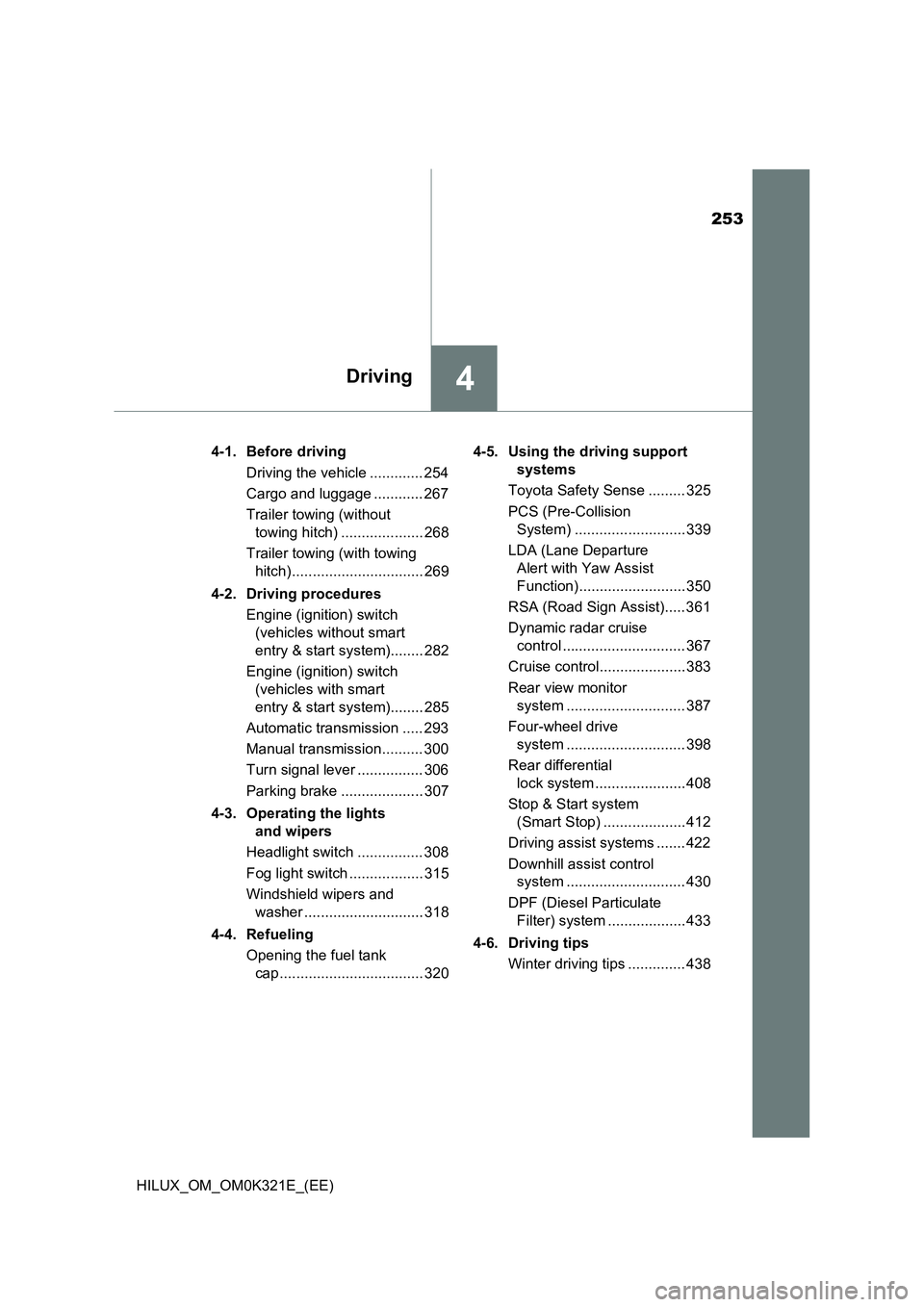
253
4Driving
HILUX_OM_OM0K321E_(EE)
4-1. Before driving
Driving the vehicle ............. 254
Cargo and luggage ............ 267
Trailer towing (without
towing hitch) .................... 268
Trailer towing (with towing
hitch)................................ 269
4-2. Driving procedures
Engine (ignition) switch
(vehicles without smart
entry & start system)........ 282
Engine (ignition) switch
(vehicles with smart
entry & start system)........ 285
Automatic transmission ..... 293
Manual transmission.......... 300
Turn signal lever ................ 306
Parking brake .................... 307
4-3. Operating the lights
and wipers
Headlight switch ................ 308
Fog light switch .................. 315
Windshield wipers and
washer ............................. 318
4-4. Refueling
Opening the fuel tank
cap ................................... 320
4-5. Using the driving support
systems
Toyota Safety Sense ......... 325
PCS (Pre-Collision
System) ........................... 339
LDA (Lane Departure
Alert with Yaw Assist
Function).......................... 350
RSA (Road Sign Assist)..... 361
Dynamic radar cruise
control .............................. 367
Cruise control..................... 383
Rear view monitor
system ............................. 387
Four-wheel drive
system ............................. 398
Rear differential
lock system ...................... 408
Stop & Start system
(Smart Stop) .................... 412
Driving assist systems ....... 422
Downhill assist control
system ............................. 430
DPF (Diesel Particulate
Filter) system ................... 433
4-6. Driving tips
Winter driving tips .............. 438
Page 263 of 744
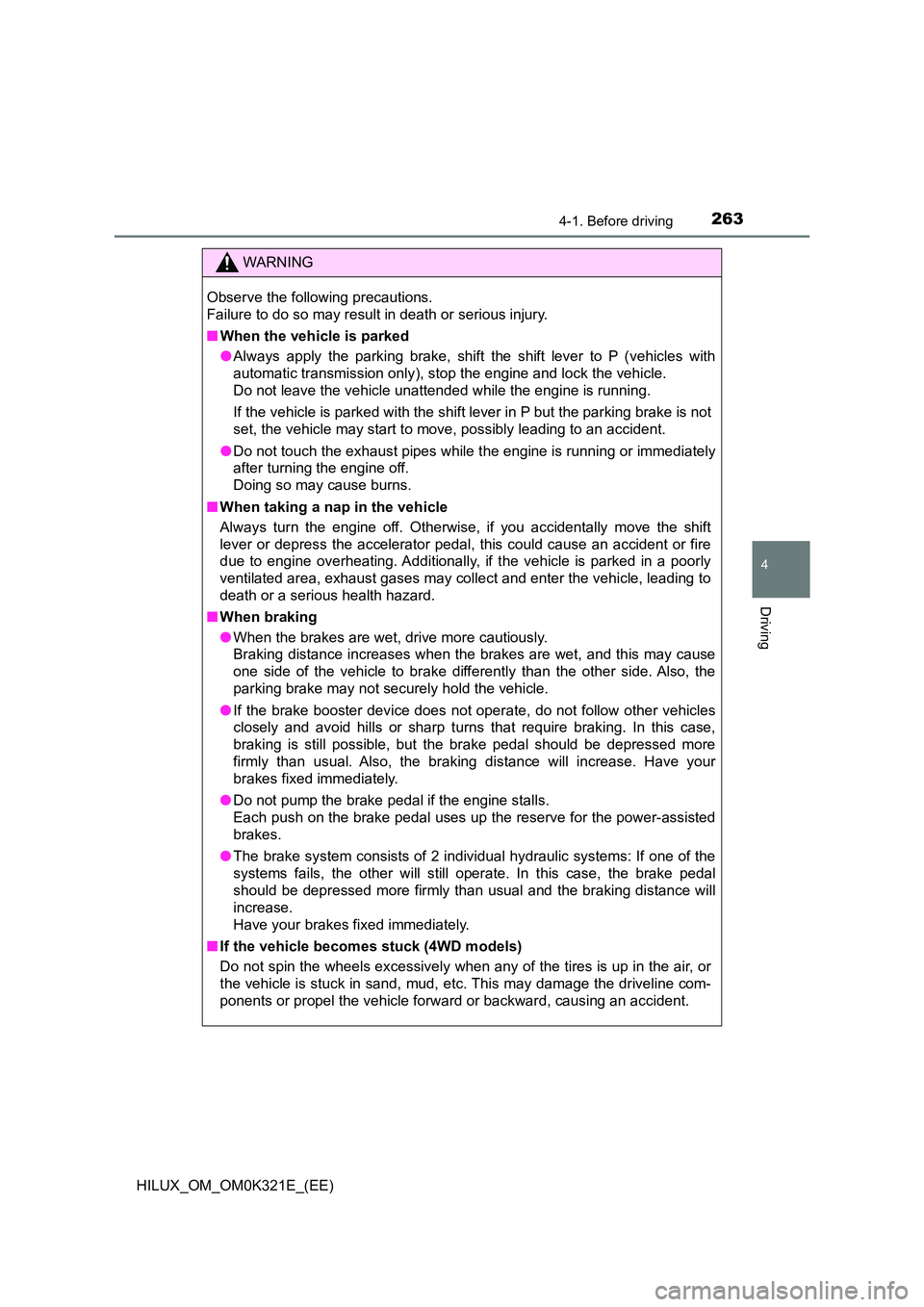
2634-1. Before driving
4
Driving
HILUX_OM_OM0K321E_(EE)
WARNING
Observe the following precautions.
Failure to do so may result in death or serious injury.
■ When the vehicle is parked
● Always apply the parking brake, shift the shift lever to P (vehicles with
automatic transmission only), stop the engine and lock the vehicle.
Do not leave the vehicle unattended while the engine is running.
If the vehicle is parked with the shift lever in P but the parking brake is not
set, the vehicle may start to move, possibly leading to an accident.
● Do not touch the exhaust pipes while the engine is running or immediately
after turning the engine off.
Doing so may cause burns.
■ When taking a nap in the vehicle
Always turn the engine off. Otherwise, if you accidentally move the shift
lever or depress the accelerator pedal, this could cause an accident or fire
due to engine overheating. Additionally, if the vehicle is parked in a poorly
ventilated area, exhaust gases may collect and enter the vehicle, leading to
death or a serious health hazard.
■ When braking
● When the brakes are wet, drive more cautiously.
Braking distance increases when the brakes are wet, and this may cause
one side of the vehicle to brake differently than the other side. Also, the
parking brake may not securely hold the vehicle.
● If the brake booster device does not operate, do not follow other vehicles
closely and avoid hills or sharp turns that require braking. In this case,
braking is still possible, but the brake pedal should be depressed more
firmly than usual. Also, the braking distance will increase. Have your
brakes fixed immediately.
● Do not pump the brake pedal if the engine stalls.
Each push on the brake pedal uses up the reserve for the power-assisted
brakes.
● The brake system consists of 2 individual hydraulic systems: If one of the
systems fails, the other will still operate. In this case, the brake pedal
should be depressed more firmly than usual and the braking distance will
increase.
Have your brakes fixed immediately.
■ If the vehicle becomes stuck (4WD models)
Do not spin the wheels excessively when any of the tires is up in the air, or
the vehicle is stuck in sand, mud, etc. This may damage the driveline com-
ponents or propel the vehicle forward or backward, causing an accident.
Page 387 of 744
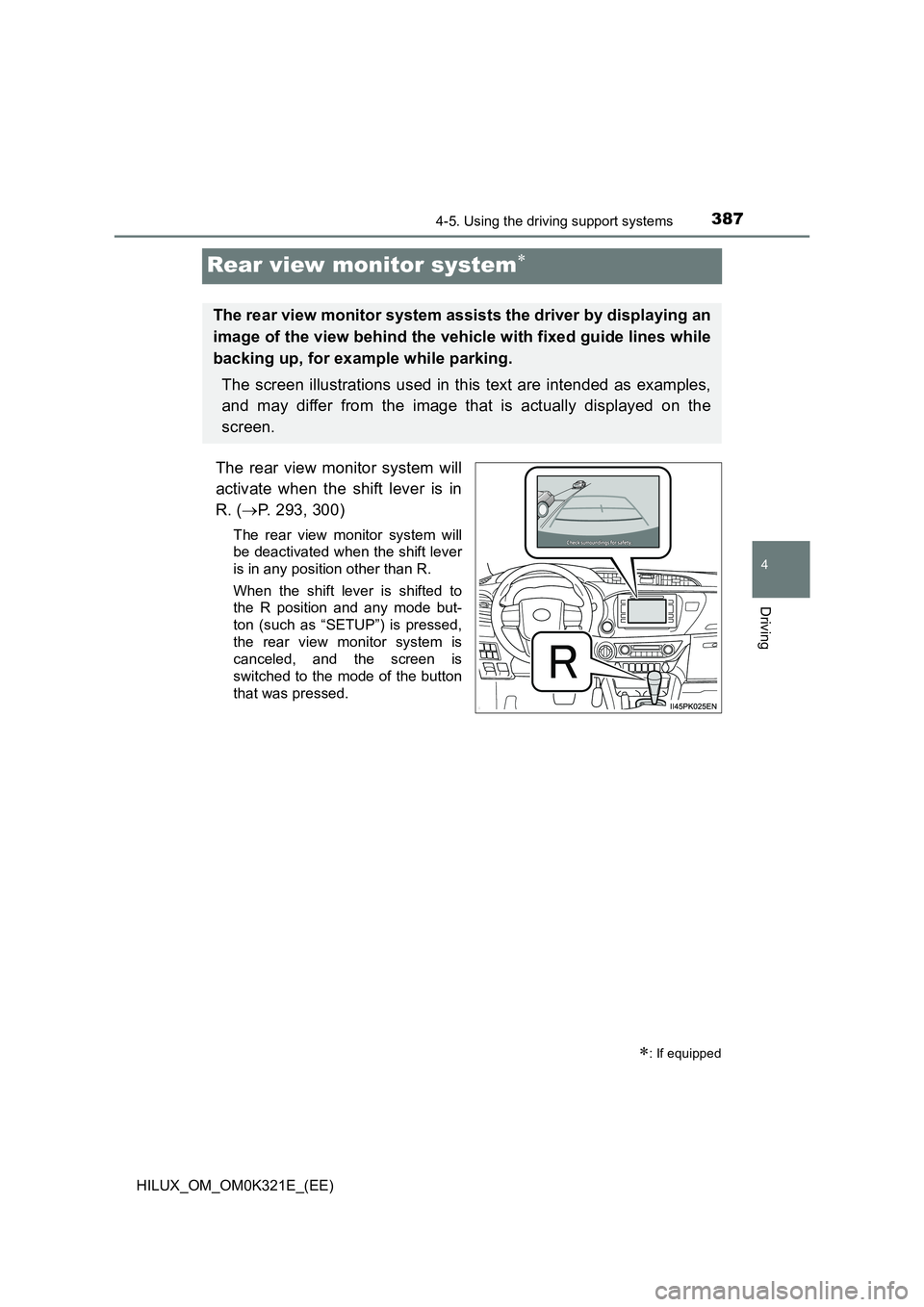
387
4
4-5. Using the driving support systems
Driving
HILUX_OM_OM0K321E_(EE)
Rear view monitor system
The rear view monitor system will
activate when the shift lever is in
R. ( P. 293, 300)
The rear view monitor system will
be deactivated when the shift lever
is in any position other than R.
When the shift lever is shifted to
the R position and any mode but-
ton (such as “SETUP”) is pressed,
the rear view monitor system is
canceled, and the screen is
switched to the mode of the button
that was pressed.
: If equipped
The rear view monitor system assists the driver by displaying an
image of the view behind the vehicle with fixed guide lines while
backing up, for example while parking.
The screen illustrations used in this text are intended as examples,
and may differ from the image that is actually displayed on the
screen.
Page 396 of 744
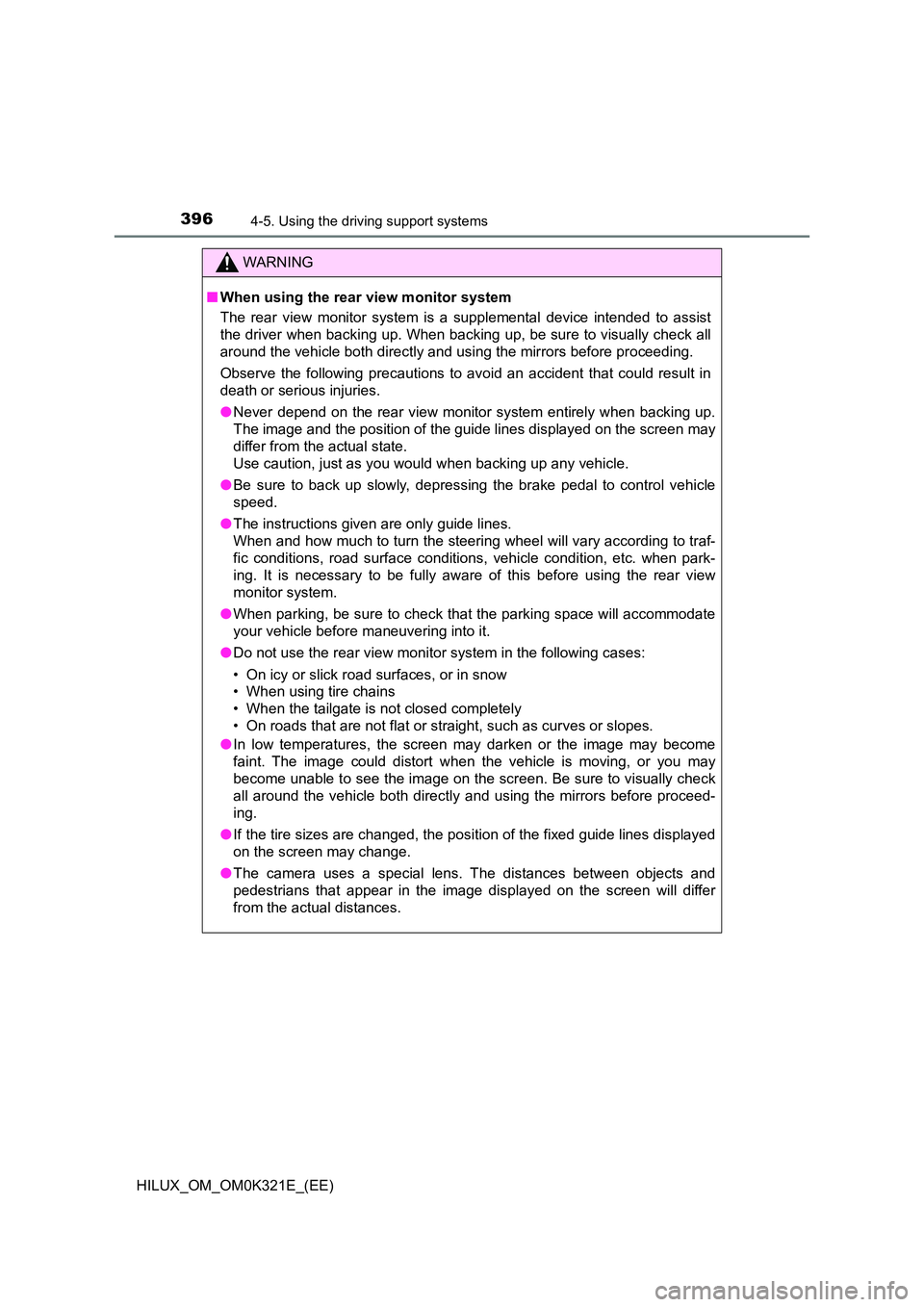
3964-5. Using the driving support systems
HILUX_OM_OM0K321E_(EE)
WARNING
■When using the rear view monitor system
The rear view monitor system is a supplemental device intended to assist
the driver when backing up. When backing up, be sure to visually check all
around the vehicle both directly and using the mirrors before proceeding.
Observe the following precautions to avoid an accident that could result in
death or serious injuries.
● Never depend on the rear view monitor system entirely when backing up.
The image and the position of the guide lines displayed on the screen may
differ from the actual state.
Use caution, just as you would when backing up any vehicle.
● Be sure to back up slowly, depressing the brake pedal to control vehicle
speed.
● The instructions given are only guide lines.
When and how much to turn the steering wheel will vary according to traf-
fic conditions, road surface conditions , vehicle condition, etc. when park-
ing. It is necessary to be fully aware of this before using the rear view
monitor system.
● When parking, be sure to check that the parking space will accommodate
your vehicle before maneuvering into it.
● Do not use the rear view monitor system in the following cases:
• On icy or slick road surfaces, or in snow
• When using tire chains
• When the tailgate is not closed completely
• On roads that are not flat or straight, such as curves or slopes.
● In low temperatures, the screen may darken or the image may become
faint. The image could distort when the vehicle is moving, or you may
become unable to see the image on the screen. Be sure to visually check
all around the vehicle both directly and using the mirrors before proceed-
ing.
● If the tire sizes are changed, the position of the fixed guide lines displayed
on the screen may change.
● The camera uses a special lens. The distances between objects and
pedestrians that appear in the image displayed on the screen will differ
from the actual distances.
Page 426 of 744
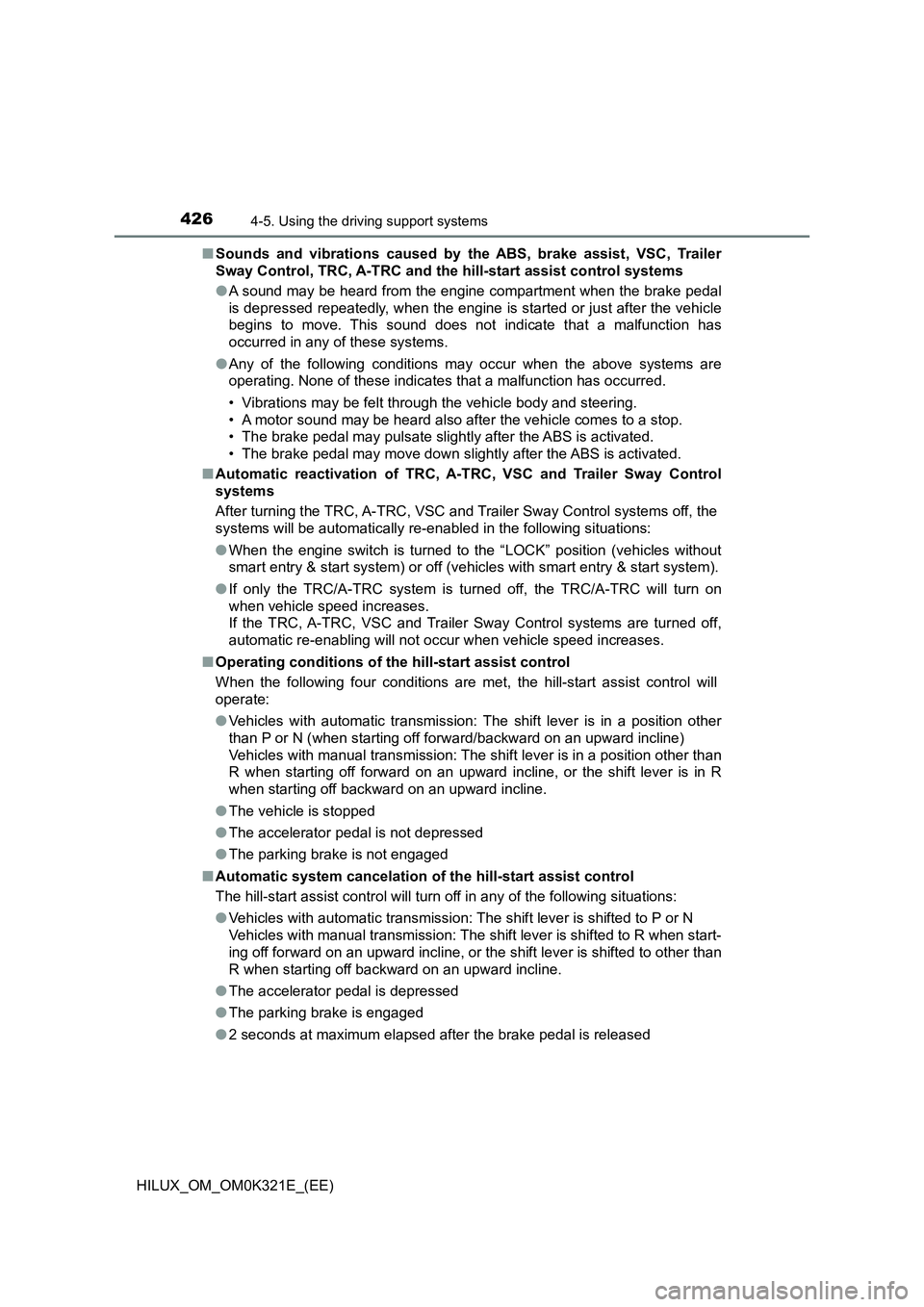
4264-5. Using the driving support systems
HILUX_OM_OM0K321E_(EE)
■ Sounds and vibrations caused by the ABS, brake assist, VSC, Trailer
Sway Control, TRC, A-TRC and the hill-start assist control systems
● A sound may be heard from the engine compartment when the brake pedal
is depressed repeatedly, when the engine is started or just after the vehicle
begins to move. This sound does not indicate that a malfunction has
occurred in any of these systems.
● Any of the following conditions may occur when the above systems are
operating. None of these indicates that a malfunction has occurred.
• Vibrations may be felt through the vehicle body and steering.
• A motor sound may be heard also after the vehicle comes to a stop.
• The brake pedal may pulsate slightly after the ABS is activated.
• The brake pedal may move down slightly after the ABS is activated.
■ Automatic reactivation of TRC, A-TRC, VSC and Trailer Sway Control
systems
After turning the TRC, A-TRC, VSC and Trailer Sway Control systems off, the
systems will be automatically re-enabled in the following situations:
● When the engine switch is turned to the “LOCK” position (vehicles without
smart entry & start system) or off (vehicles with smart entry & start system).
● If only the TRC/A-TRC system is turned off, the TRC/A-TRC will turn on
when vehicle speed increases.
If the TRC, A-TRC, VSC and Trailer Sway Control systems are turned off,
automatic re-enabling will not occur when vehicle speed increases.
■ Operating conditions of the hill-start assist control
When the following four conditions are me t, the hill-start assist control will
operate:
● Vehicles with automatic transmission: The shift lever is in a position other
than P or N (when starting off forward/backward on an upward incline)
Vehicles with manual transmission: The shift lever is in a position other than
R when starting off forward on an upward incline, or the shift lever is in R
when starting off backward on an upward incline.
● The vehicle is stopped
● The accelerator pedal is not depressed
● The parking brake is not engaged
■ Automatic system cancelation of the hill-start assist control
The hill-start assist control will turn off in any of the following situations:
● Vehicles with automatic transmission: The shift lever is shifted to P or N
Vehicles with manual transmission: The shift lever is shifted to R when start-
ing off forward on an upward incline, or the shift lever is shifted to other than
R when starting off backward on an upward incline.
● The accelerator pedal is depressed
● The parking brake is engaged
● 2 seconds at maximum elapsed after the brake pedal is released
Page 428 of 744

4284-5. Using the driving support systems
HILUX_OM_OM0K321E_(EE)
WARNING
■TRC/A-TRC/VSC may not operate effectively when
Directional control and power may not be achievable while driving on slip-
pery road surfaces, even if the TRC/A-TRC/VSC system is operating.
Drive the vehicle carefully in conditions where stability and power may be
lost.
■ Hill-start assist control does not operate effectively when
● Do not overly rely on the hill-start assist control. The hill-start assist control
may not operate effectively on steep inclines and roads covered with ice.
● Unlike the parking brake, the hill-start assist control is not intended to hold
the vehicle stationary for an extended period of time. Do not attempt to use
the hill-start assist control to hold the vehicle on an incline, as doing so
may lead to an accident.
■ When the TRC/VSC/Trailer Sway Control is activated
The slip indicator flashes. Always drive carefully.
Reckless driving may cause an accident. Exercise particular care when the
indicator flashes.
■ When the TRC/A-TRC/VSC/Trailer Sway Control systems are turned off
Be especially careful and drive at a speed appropriate to the road condi-
tions. As these are the systems to help ensure vehicle stability and driving
force, do not turn the TRC/A-TRC/VSC/Trailer Sway Control systems off
unless necessary.
■ Replacing tires
Make sure that all tires are of the specified size, brand, tread pattern and
total load capacity. In addition, make sure that the tires are inflated to the
recommended tire inflation pressure level.
The ABS, TRC, A-TRC, VSC, Trailer Sway Control, hill-start assist control
and downhill assist control systems will not function correctly if different tires
are installed on the vehicle.
Contact any authorized Toyota retailer or Toyota authorized repairer, or any
reliable repairer for further information when replacing tires or wheels.
■ Handling of tires and the suspension
Using tires with any kind of problem or modifying the suspension will affect
the driving assist systems, and may cause a system to malfunction.
Page 733 of 744

733Alphabetical index
HILUX_OM_OM0K321E_(EE)
Automatic air conditioning
system
Air conditioning filter.............. 597
Automatic air conditioning
system ................................ 526
Automatic disconnecting
differential .............................. 398
Automatic light
control system ....................... 312
Automatic transmission .......... 293
If the shift lever cannot be
shifted from P ..................... 298
AUX port*................................. 480
Auxiliary boxes ........................ 544
Back-up lights
Replacing light bulbs ............. 618
Wattage................................. 714
Battery
Battery checking ................... 578
If the vehicle battery is
discharged .......................... 672
Preparing and checking
before winter....................... 438
Warning light ......................... 634
Bluetooth®*.............................. 508
Audio system ........................ 501
Hands-free system
(for cellular phone).............. 481
Registering/removing a
Bluetooth® device ............... 489
Selecting a Bluetooth®
device ......................... 490, 491
Wireless
communication ................... 481
Bluetooth® audio*................... 481
Bluetooth® phone*.................. 481
Deleting the call history......... 496
Making a call ......................... 503
Managing speed dials ........... 503
Managing the contacts.......... 498
Phone settings ...................... 494
Receiving a call..................... 505
Speaking on the phone ......... 503
Bottle holders .......................... 543
Brake
Fluid ...................................... 710
Override system warning
light..................................... 637
Parking brake........................ 307
Warning light ......................... 634
Brake assist ............................. 422
Break-in tips ............................. 257
Brightness control
Instrument panel light
control................................. 144
Care
Aluminum wheels.................. 557
Exterior ................................. 556
Interior................................... 560
Seat belts .............................. 561
CD player*................................ 455
Chains....................................... 439
Child restraint system ............... 67
Child restraint system
installation method ............... 91
Fixed with a seat belt .............. 92
Fixed with an ISOFIX lower
anchorage ............................ 94
Points to remember ................ 68
Riding with children................. 66
Using a top tether
anchorage ............................ 97
B
C
*: Refer to “Navigation and multimedia system Owner’s manual”.